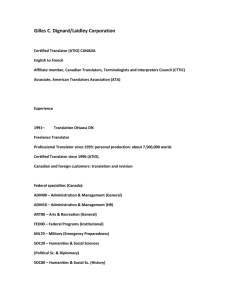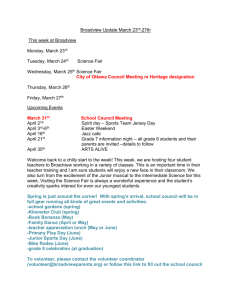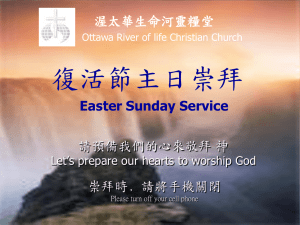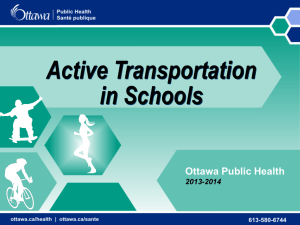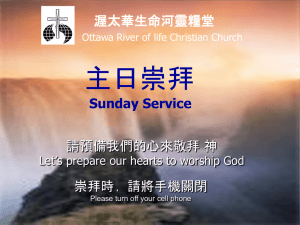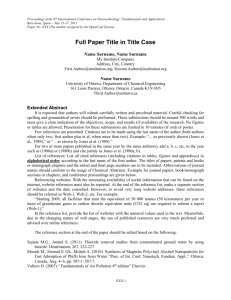SURP-826 Project Course (Land Use and Real Estate Development)
advertisement
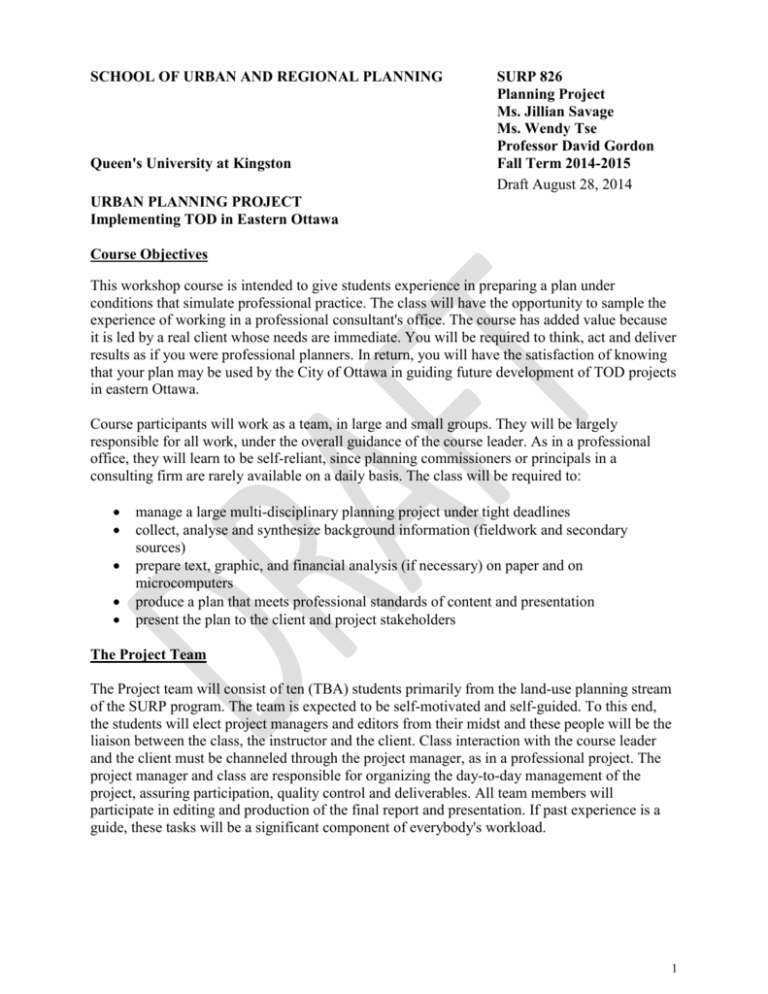
SCHOOL OF URBAN AND REGIONAL PLANNING Queen's University at Kingston SURP 826 Planning Project Ms. Jillian Savage Ms. Wendy Tse Professor David Gordon Fall Term 2014-2015 Draft August 28, 2014 URBAN PLANNING PROJECT Implementing TOD in Eastern Ottawa Course Objectives This workshop course is intended to give students experience in preparing a plan under conditions that simulate professional practice. The class will have the opportunity to sample the experience of working in a professional consultant's office. The course has added value because it is led by a real client whose needs are immediate. You will be required to think, act and deliver results as if you were professional planners. In return, you will have the satisfaction of knowing that your plan may be used by the City of Ottawa in guiding future development of TOD projects in eastern Ottawa. Course participants will work as a team, in large and small groups. They will be largely responsible for all work, under the overall guidance of the course leader. As in a professional office, they will learn to be self-reliant, since planning commissioners or principals in a consulting firm are rarely available on a daily basis. The class will be required to: manage a large multi-disciplinary planning project under tight deadlines collect, analyse and synthesize background information (fieldwork and secondary sources) prepare text, graphic, and financial analysis (if necessary) on paper and on microcomputers produce a plan that meets professional standards of content and presentation present the plan to the client and project stakeholders The Project Team The Project team will consist of ten (TBA) students primarily from the land-use planning stream of the SURP program. The team is expected to be self-motivated and self-guided. To this end, the students will elect project managers and editors from their midst and these people will be the liaison between the class, the instructor and the client. Class interaction with the course leader and the client must be channeled through the project manager, as in a professional project. The project manager and class are responsible for organizing the day-to-day management of the project, assuring participation, quality control and deliverables. All team members will participate in editing and production of the final report and presentation. If past experience is a guide, these tasks will be a significant component of everybody's workload. 1 Project Coaches and Co-ordinator The City of Ottawa provides senior professional staff who will act as coaches and be the principal contact with the students. The principal project coach has been appointed an adjunct instructor at SURP: Jillian Savage MCIP, RPP Senior Planner, Policy Development and Urban Design Branch, Planning and Growth Management Department, City of Ottawa 613-580-2424 ext. 14970 Jillian.Savage@ottawa.ca Wendy Tse, MCIP, RPP, LEED Green Associate Senior Planner, Policy Development and Urban Design Branch Planning and Growth Management Department, City of Ottawa 613-580-2424, ext. 12585 Wendy.Tse@ottawa.ca The course will be coordinated by Dr. David Gordon, MCIP. Professor Gordon will provide strategic guidance, budgetary approval, technical assistance, quality control and assist with evaluation. David Gordon School of Urban and Regional Planning, Queen's University 613-533-6000 ext. 77063 david.gordon@queensu.ca The Client The client for this project is the City of Ottawa's Policy Development and Urban Design branch within the Planning and Growth Management department. Senior staff will act as our liaison and principal instructor. The Policy Development and Urban Design branch is responsible for land use, environmental, and infrastructure policy; review of the Official Plan and Infrastructure Master Plan; urban design and community design; research and forecasting; and, zoning studies. Their strategic focus aims to establish distinct, liveable communities and healthy environments though sustainable planning methods such as mixed-use, transit-oriented development and intensification at key locations. The City of Ottawa's interesting mix of urban, suburban and rural communities is the result of amalgamation in 2001, which involved the Region of OttawaCarleton and 11 local municipalities. Currently, the City serves approximately over 940,000 people in almost 400,000 households. Ottawa's population is projected to grow to 1.1 million by 2031 and the number of households is expected to increase to approximately 490,000. The Site – Tremblay Station and the Eastern LRT Corridor The City of Ottawa has adopted a series of Transit-Oriented Development (TOD) Plans in support of Phase 1 of its Light Rail Transit (LRT) Project. http://ottawa.ca/en/city-hall/public-consultations/planning-and-infrastructure/lrt-station-area- 2 transit-oriented The TOD Plans set the stage for redevelopment by creating the regulatory framework to stimulate development that is dense, innovative, integrated and of high-quality urban design in the vicinity of the proposed LRT stations. The Plans emphasize well-designed, compact neighbourhoods where residents can live, work, shop and play close by, complete daily activities easily, access viable transit, and support local businesses. Although the TOD plans have stimulated significant development activity in central and western Ottawa, very little has been developed near transit stations in eastern Ottawa, and there are few active proposals. Land has sat idle or undeveloped near the Tremblay (Train), Cyrville and Blair stations for decades. The area is approximately 100 ha in size and is located roughly 4 km east of downtown. The Tremblay Station is one of the existing Bus Rapid Transit (BRT) Stations which will be converted into an LRT Station as part of Phase 1 of the Implementation Plan for the Confederation Line. http://www.confederationline.ca/ Some characteristics of the station area include: - A multi-modal stop (LRT, VIA rail, potentially bus?) - Public land holdings: Canada Post, VIA Rail - City land holdings: baseball stadium - Some (successful) big box retailers in the area (i.e. Ottawa Train Yards Shopping) - A range of smaller and larger-sized properties - A pedestrian bridge currently under construction over HWY - An 8-storey Federal government office building recently constructed (for CRA) - Several light industrial properties - Utility buildings The lands to be addressed by this TOD study are designated by the Official Plan (OP) as MixedUse Centre, General Urban Area and Employment Area, as per “Schedule B – Urban Policy Plan”. “Schedule D – Primary Transit Network” of the OP illustrates the location of the existing Bus Rapid Transitway, and Transit Station for both LRT and Bus in relation to the study area. A “Design Priority Area” (DPA) overlay reflects the boundary of the lands designated as MixedUse Centre. Policies for DPAs require new developments to contribute “to an enhanced pedestrian environment and to address the distinct character and unique opportunities of the area” and are subject to the Urban Design Review Panel process. The Tremblay Station study area is one of 11 Mixed-Use Centres that have Official Plan Density Requirements and are subject to Density Index Zoning Requirements. Figure 2.3 of the Official Plan sets out minimum density requirements expressed in jobs and people per gross hectare. For the Tremblay Mixed-Use Centre, the density requirement is 250 jobs and people per gross hectare post-2031. The 2012 target was 53 jobs and people per gross hectare. Planning Issues 3 The City’s Strategic Plan and, in turn, the OP and Transportation Master Plan establish the priorities and policy framework for making decisions and managing growth in Ottawa. These documents and other municipal implementation tools reinforce the qualities that are most valued by City residents and also provide the policy direction for this project. Issues to be investigated: TOD Implementation: The team will analyze current conditions in the area along the eastern corridor and identify appropriate Canadian and international precedents for good TOD implementation beyond establishing conventional policy and zoning regulations. Students will analyze plans for specific areas; identify key policies, recommend tools or strategies to ensure successful implementation and prepare a financial strategy for a demonstration plan at the Tremblay Station area. Retrofitting, intensifying and planned phasing: Shifting from car-oriented neighbourhoods to pedestrian and transit-oriented neighbourhoods. Introducing a new urban structure and new uses into the current fabric to increase density and achieve the desired built form over time. This course will suit students interested in land use planning and real estate. It may include aspects of other related disciplines such as community design. Project Deliverables A. Existing conditions 1. Consider and define: a. Market overview- current businesses, rental rates, housing prices, site size and configuration, vacant lots b. The demographic, employment and housing profile c. Boundaries of the community and entryways d. Relationship to adjacent communities e. Community focal points, centres of activity f. Existing community resources- schools, community centres, parks, greenspace g. Transportation and infrastructure capacities' conditions, alignments h. Natural resources, functions and values in the area i. Pedestrian and cycling networks; linkages to adjacent communities j. Remaining elements of valued historic development patterns k. Views, vistas, landscapes, features landmarks l. Existing character of the built form – design elements, heritage resources, visual cues m. Floodplains, unstable slopes, contamination, other constraints n. Current development applications 2. Review and analyze relevant planning documentation such as the Tremblay Road TOD Plan; other TOD Plans; Official Plan, City Strategic Plan, Transportation Master Plan, Ottawa Cycling Plan, Ottawa Pedestrian Plan, Zoning Bylaw, various Urban Design Guidelines and other related studies. B. Summary of Key Observations: 4 1. Define the current policy context, market conditions, urban form, and understand the existing municipal framework (and the potential limitations therein) 2. Identify Strengths, Weaknesses, Opportunities, Threats (SWOT) C. TOD Implementation Options: 1. Examine the theoretical basis for implementing transit-oriented development. 2. Prepare a compendium of best-practice case studies for implementation of TOD. 3. Identify which TOD implementation strategies may be most appropriate for the City of Ottawa to consider for the Tremblay Station area. D. TOD Implementation Strategy for Tremblay Station and immediate area: 1. Review the plan for the Tremblay Station area. 2. Develop policy recommendations and potential implementation strategies to achieve the plan 3. Prepare a financial strategy and pro-forma budget for implementation of the TOD plan. The deliverables are chapter-by-chapter components of the final report, including an inventory, evaluation and policy recommendations. In other words, preparation of the final report starts at the beginning of the project. Resources The Project team will be provided with a number of hard copy and electronic files from the City of Ottawa that will assist in determining existing conditions of the area. A catalogue of all documents will be provided. A number of maps will also be provided in hard copy and digital file. In addition, a Resource List with links to files, maps, and tools online will be included. The City of Ottawa's website is an excellent resource and it is recommended that students become familiar with the materials available there. Proposed Evaluation Mid-term report chapters Mid-term presentation Final report (including maps and diagrams) and supporting reports Final presentation (including the use of visual aids, e.g., PowerPoint) Peer evaluation* 10% 10% 50% 20% 10% *each student is required to evaluate all other students enrolled in the project course. Additional information on peer evaluation will be provided in the first week of the course. N.B.: This is a professional practice course. Presentation dates are set in advance with the cooperation of the client. Late submission of written material, including the final report, is discouraged and will be subject to the usual penalty of 1% per day. Since the final report is a 5 group project, all students in the class will be responsible for its completion. There will be some discretion on the part of the course coordinator in assigning additional marks for merit to the course managers. Budget The course sponsor has agreed in principle to provide a small budget to cover course expenses. The City of Ottawa, with the help of other key stakeholders has agreed to provide base plans, selected reports and digital information. The sponsor will cover the cost of field trips and reproduction of the report. The project manager, project treasurer and the instructor will confirm the available budget at the beginning of term and will approve and monitor expenses throughout. The managers must monitor the design and format of the final report to ensure that copies for the project team are affordable within the budget. However, students may incur some costs for telephone calls, faxes reports or materials that would not be covered by our modest budget for these items. Schedule Wednesdays and Fridays between 2:30 pm and 5:30 pm for formal meetings. Most classes take place on Wednesdays, from 2:30 pm to 5:30 pm, unless arranged otherwise by the project manager, course instructor or the course coach. The first field trip to Ottawa is scheduled for Friday, September 12th. PROJECT STAGES Note: This is a suggested schedule for the entire course, intended to give participants an overview of the content and deliverables at each stage. However, this course is being run on the model of a consultant study, in which considerable flexibility is retained in order to respond to issues as they arise. The class and their project manager will be responsible for creating their own schedule and fine-tuning it throughout the term. Stage 1 - Orientation and Background Research 1a. Tuesday, September 9, 2:30-3:30 Course Orientation and Team Organization Introduction to the faculty and course pedagogical objectives (faculty) Review of roles of faculty and adjunct instructors Orientation to the course and expectations Discussion of course protocols, roles and responsibilities Workshop: project management techniques and planning processes Location: SURP Sutherland Hall 554 Deliverables: None 6 1b. Wednesday, September 12:30 - 5:30 Project Orientation and Team Organization Overview of site & client interest (video conference or teleconference) Review of resources available Orientation to the project and expectations Election of project manager(s) Election of treasurer Location: SURP Sutherland Hall 554 Deliverables: None 2. Friday, September 12, 7:00am- 11:00 pm Field trip to Ottawa by bus Site visit by windshield survey Meeting with adjunct instructor & client staff (City Hall) Stakeholders meetings Site visit (morning) Field work (late morning / early afternoon) Location: Ottawa Deliverables: Meeting notes, databases of stakeholders 3. Week of September 14 - Background Research SWOT analysis Existing conditions (Data Collection, organization and evaluation) Arranging further stakeholder interviews (if necessary) TOD implementation comparison- Research into greyfields intensification approaches Consideration of plan implementation instrument approaches (criteria, format, etc.) Location: SURP Sutherland Hall 554 Deliverables: Confirmation of project management team structure and budget. Presentation of work-in-progress interview notes, precedent examples, TOD implementation research, etc. 4. Week of September 21- Background Research SWOT analysis continues Existing Conditions (data collection, organization and evaluation) Stakeholder interviews TOD implementation comparison- ongoing research Consideration of plan implementation instrument approaches (criteria, format, etc.) Location: SURP Sutherland Hall 554 Deliverables: Confirmation of final product (format, layout, etc.) Presentation of work-inprogress: interview notes, precedent examples, sustainability research, etc. 7 5. Week of September 28- Project Analysis Stakeholder interviews complete Workshop- precedent and policy analysis Preliminary Strategies for Tremblay Station corridor Location: SURP Sutherland Hall 554 Deliverables: Presentation of work-in-progress; chapter outline for policy analysis; stakeholder analysis; intensification analysis and framework for application to the Tremblay Station area Stage II - Evaluation 6. Week of October 5 - Mid-Term Status Report Project team prepares for next week's presentation of preliminary findings (mid-project report) Identification of strategic issues Identification of "best-guess” response and alternatives Focus on intensification and greyfield redevelopment Location: SURP Sutherland Hall 554 Deliverables: Policy analysis; stakeholder analysis; precedent catalogue, draft report chapters for grading. 7. Week of October 12 - Presentation of Preliminary Findings Informal workshop setting presentation by team to coaches and stakeholders Full presentation of work-in-progress (issues and options) Critique and recommendations for changes discussed Brainstorming session on policy options Issues: findings of analysis to date, exploration of alternatives, report format, considerations, additional research needs, etc. Location: SURP Sutherland Hall 554 8. Friday, October 17 (?) - Charrette with City of Ottawa Staff (optional) At the discretion of the project team, and in discussion with the client,a charrette will be held to work through outstanding issues in the project. The Project Team must decide whether to hold the charrette by Friday, September 26. Location: SURP 9. Week of October 16 - Planning Recommendations Begin preparation of draft report, policies and planning instruments Refine site design options Advanced development of report template Prepare implementation strategy, draft subdivision and site Report and Presentation evaluation rubrics provided 8 Location: SURP Deliverables: Draft report chapters (issues paper, opportunities, explanation of future directions); implementation strategy; final presentation to coaches and critique. 10. Week of October 26 - Project Refinements Workshop and studio format Team continues to refine site designs Fill in missing research gaps Refine project report format Refine presentation- style, roles and responsibilities Location: SURP Sutherland Hall 554 Deliverables: Status report on above; status report forwarded to coaches for comments and direction. 11. Week of November 9 - Project Refinements Workshop and studio format Team continues to refine plan and report based on Client's comments Fill in missing research gaps Complete design drawings Refine project report format Refine presentation- style, roles and responsibilities Location: SURP Deliverables: status report on above. 12. Week of November 16 - Draft Report complete Draft report written and supporting graphics continue Revised design drawings Final research additions Deliverables: Executive summary outline presented to coaches Stage III – Final Report and Presentations 13. Week of November 19 - Executive Summary and Presentation Executive summary completed Report graphics completed Presentation outline prepared Deliverables: Executive summary, presentation outline. 14. Week of November 23 - Executive Summary and Rehearsal Draft report completed for review Presentation graphics completed 9 Presentation prepared for faculty Presentation rehearsal for faculty and student review Deliverable: December 1 - Revised report submitted to coaches for review and evaluation; printer organized and quote obtained 14. Friday, Friday, November 28 - Presentation to Faculty and School Team to present findings in presentation to faculty and fellow students in special session Presentation to include audio-visual support, models, graphics, maps and schemes Critique and guidance provided re: changes required Comparison to other team presentations Location: SURP Sutherland Hall 554 Deliverables: Full-scale audio-visual presentation developed. 16. Week of Nov. 30/ Dec. 7- Presentation to Client and Stakeholders Full-scale audio-visual presentation to client and stakeholders, accompanied by handouts Questions and answers in 'breakout' sessions Discussion, advice, re: changes, directions, etc. Organize changes to final report Location: Ottawa City Hall Deliverables: Professional-quality presentation; schedule for report amendments Week of December 7 - Coaches return report with minor amendments; printing cost confirmed Friday December 19 - Final report delivered to printer for reproduction 10
